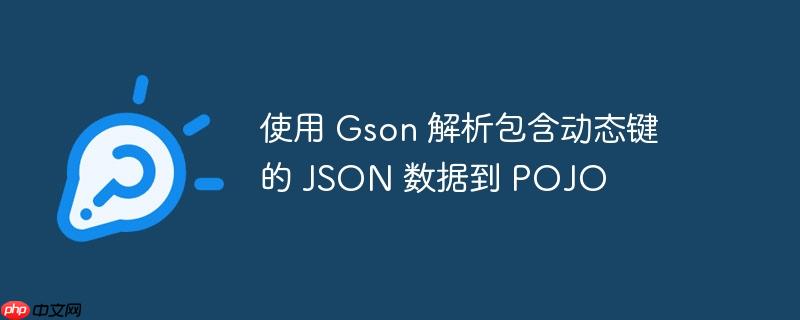
本文档旨在帮助开发者理解如何使用 Gson 库解析包含动态键的 JSON 数据,并将其映射到 Java POJO (Plain Old Java Object) 类中。我们将通过一个股票行情数据的例子,详细介绍如何正确地定义 POJO 类结构,以及如何使用 Gson 进行反序列化,解决Retrofit2返回null的问题。
在处理包含动态键的 JSON 数据时,关键在于理解数据的结构,并设计合适的 POJO 类来映射它。例如,考虑以下 JSON 结构:
{
"Meta Data": {
"1. Information": "Intraday (5min) open, high, low, close prices and volume",
"2. Symbol": "IBM",
"3. Last Refreshed": "2022-10-26 19:40:00",
"4. Interval": "5min",
"5. Output Size": "Compact",
"6. Time Zone": "US/Eastern"
},
"Time Series (5min)": {
"2022-10-26 19:40:00": {
"1. open": "135.0600",
"2. high": "135.0700",
"3. low": "135.0400",
"4. close": "135.0700",
"5. volume": "500"
},
"2022-10-26 19:05:00": {
"1. open": "135.3500",
"2. high": "135.3500",
"3. low": "135.3500",
"4. close": "135.3500",
"5. volume": "106"
}
}
}在这个例子中,"Time Series (5min)" 下的键是动态的,代表不同的时间戳。我们需要使用 Map<String, Date> 来映射这种结构,其中 String 是时间戳,Date 是包含股票数据的 POJO 类。
以下是对应的 POJO 类定义:
import com.google.gson.annotations.Expose;
import com.google.gson.annotations.SerializedName;
import java.util.Map;
public class DailyQuote {
@SerializedName("Meta Data")
@Expose
private MetaData metaData;
@SerializedName("Time Series (5min)")
@Expose
private Map<String, Date> timeSeries; // 修改为 Map<String, Date>
public DailyQuote() {
}
public DailyQuote(MetaData metaData, Map<String, Date> timeSeries) {
this.metaData = metaData;
this.timeSeries = timeSeries;
}
public MetaData getMetaData() {
return metaData;
}
public void setMetaData(MetaData metaData) {
this.metaData = metaData;
}
public Map<String, Date> getTimeSeries() {
return timeSeries;
}
public void setTimeSeries(Map<String, Date> timeSeries) {
this.timeSeries = timeSeries;
}
}
public class MetaData {
@SerializedName("1. Information")
@Expose
private String _1Information;
@SerializedName("2. Symbol")
@Expose
private String _2Symbol;
@SerializedName("3. Last Refreshed")
@Expose
private String _3LastRefreshed;
@SerializedName("4. Interval")
@Expose
private String _4Interval;
@SerializedName("5. Output Size")
@Expose
private String _5OutputSize;
@SerializedName("6. Time Zone")
@Expose
private String _6TimeZone;
public MetaData() {
}
public MetaData(String _1Information, String _2Symbol, String _3LastRefreshed, String _4Interval, String _5OutputSize, String _6TimeZone) {
this._1Information = _1Information;
this._2Symbol = _2Symbol;
this._3LastRefreshed = _3LastRefreshed;
this._4Interval = _4Interval;
this._5OutputSize = _5OutputSize;
this._6TimeZone = _6TimeZone;
}
public String get1Information() {
return _1Information;
}
public void set1Information(String _1Information) {
this._1Information = _1Information;
}
public String get2Symbol() {
return _2Symbol;
}
public void set2Symbol(String _2Symbol) {
this._2Symbol = _2Symbol;
}
public String get3LastRefreshed() {
return _3LastRefreshed;
}
public void set3LastRefreshed(String _3LastRefreshed) {
this._3LastRefreshed = _3LastRefreshed;
}
public String get4Interval() {
return _4Interval;
}
public void set4Interval(String _4Interval) {
this._4Interval = _4Interval;
}
public String get5OutputSize() {
return _5OutputSize;
}
public void set5OutputSize(String _5OutputSize) {
this._5OutputSize = _5OutputSize;
}
public String get6TimeZone() {
return _6TimeZone;
}
public void set6TimeZone(String _6TimeZone) {
this._6TimeZone = _6TimeZone;
}
}
public class Date {
@SerializedName("1. open")
@Expose
private String _1Open;
@SerializedName("2. high")
@Expose
private String _2High;
@SerializedName("3. low")
@Expose
private String _3Low;
@SerializedName("4. close")
@Expose
private String _4Close;
@SerializedName("5. volume")
@Expose
private String _5Volume;
public Date() {
}
public Date(String _1Open, String _2High, String _3Low, String _4Close, String _5Volume) {
this._1Open = _1Open;
this._2High = _2High;
this._3Low = _3Low;
this._4Close = _4Close;
this._5Volume = _5Volume;
}
public String get1Open() {
return _1Open;
}
public void set1Open(String _1Open) {
this._1Open = _1Open;
}
public String get2High() {
return _2High;
}
public void set2High(String _2High) {
this._2High = _2High;
}
public String get3Low() {
return _3Low;
}
public void set3Low(String _3Low) {
this._3Low = _3Low;
}
public String get4Close() {
return _4Close;
}
public void set4Close(String _4Close) {
this._4Close = _4Close;
}
public String get5Volume() {
return _5Volume;
}
public void set5Volume(String _5Volume) {
this._5Volume = _5Volume;
}
@Override
public String toString() {
return "List:{" +
"Open='" + get1Open() + '\'' +
", High='" + get2High() + '\'' +
", Low='" + get3Low() + '\'' +
", Close='" + get4Close() + '\'' +
", Volume='" + get5Volume();
}
}注意 DailyQuote 类中 timeSeries 字段的类型是 Map<String, Date>,而不是 TimeSeries。 TimeSeries 类不再需要,直接使用 Map<String, Date> 即可。
使用 Gson 反序列化 JSON 数据非常简单:
import com.google.gson.Gson;
public class Main {
public static void main(String[] args) {
String json = "{\n" +
" \"Meta Data\": {\n" +
" \"1. Information\": \"Intraday (5min) open, high, low, close prices and volume\",\n" +
" \"2. Symbol\": \"IBM\",\n" +
" \"3. Last Refreshed\": \"2022-10-26 19:40:00\",\n" +
" \"4. Interval\": \"5min\",\n" +
" \"5. Output Size\": \"Compact\",\n" +
" \"6. Time Zone\": \"US/Eastern\"\n" +
" },\n" +
" \"Time Series (5min)\": {\n" +
" \"2022-10-26 19:40:00\": {\n" +
" \"1. open\": \"135.0600\",\n" +
" \"2. high\": \"135.0700\",\n" +
" \"3. low\": \"135.0400\",\n" +
" \"4. close\": \"135.0700\",\n" +
" \"5. volume\": \"500\"\n" +
" },\n" +
" \"2022-10-26 19:05:00\": {\n" +
" \"1. open\": \"135.3500\",\n" +
" \"2. high\": \"135.3500\",\n" +
" \"3. low\": \"135.3500\",\n" +
" \"4. close\": \"135.3500\",\n" +
" \"5. volume\": \"106\"\n" +
" }\n" +
" }\n" +
"}";
Gson gson = new Gson();
DailyQuote dailyQuote = gson.fromJson(json, DailyQuote.class);
System.out.println("Meta Data: " + dailyQuote.getMetaData().get2Symbol());
System.out.println("Time Series: " + dailyQuote.getTimeSeries().toString());
}
}这段代码首先创建了一个 Gson 实例,然后使用 fromJson() 方法将 JSON 字符串转换为 DailyQuote 对象。
在 Retrofit 中使用 Gson,你需要确保 Gson Converter Factory 被正确配置。以下是一个简单的 Retrofit 接口定义:
import retrofit2.Call;
import retrofit2.http.GET;
public interface ApiService {
@GET("your_api_endpoint")
Call<DailyQuote> getDailyQuote();
}确保你的 Retrofit 客户端配置中包含了 Gson Converter Factory:
import retrofit2.Retrofit;
import retrofit2.converter.gson.GsonConverterFactory;
public class RetrofitClient {
private static Retrofit retrofit;
private static final String BASE_URL = "your_base_url";
public static Retrofit getRetrofitInstance() {
if (retrofit == null) {
retrofit = new Retrofit.Builder()
.baseUrl(BASE_URL)
.addConverterFactory(GsonConverterFactory.create())
.build();
}
return retrofit;
}
}然后,你可以像这样使用 Retrofit 获取数据:
import retrofit2.Call;
import retrofit2.Callback;
import retrofit2.Response;
public class NetworkCall {
public static void main(String[] args) {
ApiService apiService = RetrofitClient.getRetrofitInstance().create(ApiService.class);
Call<DailyQuote> call = apiService.getDailyQuote();
call.enqueue(new Callback<DailyQuote>() {
@Override
public void onResponse(Call<DailyQuote> call, Response<DailyQuote> response) {
if (response.isSuccessful()) {
DailyQuote dailyQuote = response.body();
System.out.println("Meta Data: " + dailyQuote.getMetaData().get2Symbol());
System.out.println("Time Series: " + dailyQuote.getTimeSeries().toString());
} else {
System.out.println("Request failed: " + response.message());
}
}
@Override
public void onFailure(Call<DailyQuote> call, Throwable t) {
System.out.println("Request failed: " + t.getMessage());
}
});
}
}通过本文,你学习了如何使用 Gson 解析包含动态键的 JSON 数据,并将其映射到 POJO 类中。关键在于理解 JSON 结构,并使用 Map<String, Object> 或自定义 POJO 类来映射动态键。结合 Retrofit,你可以轻松地从 API 获取数据,并将其转换为 Java 对象进行处理。 记住,良好的 POJO 设计和适当的 Gson 配置是成功解析 JSON 数据的关键。
以上就是使用 Gson 解析包含动态键的 JSON 数据到 POJO的详细内容,更多请关注php中文网其它相关文章!

每个人都需要一台速度更快、更稳定的 PC。随着时间的推移,垃圾文件、旧注册表数据和不必要的后台进程会占用资源并降低性能。幸运的是,许多工具可以让 Windows 保持平稳运行。

Copyright 2014-2025 https://www.php.cn/ All Rights Reserved | php.cn | 湘ICP备2023035733号